Propolis research
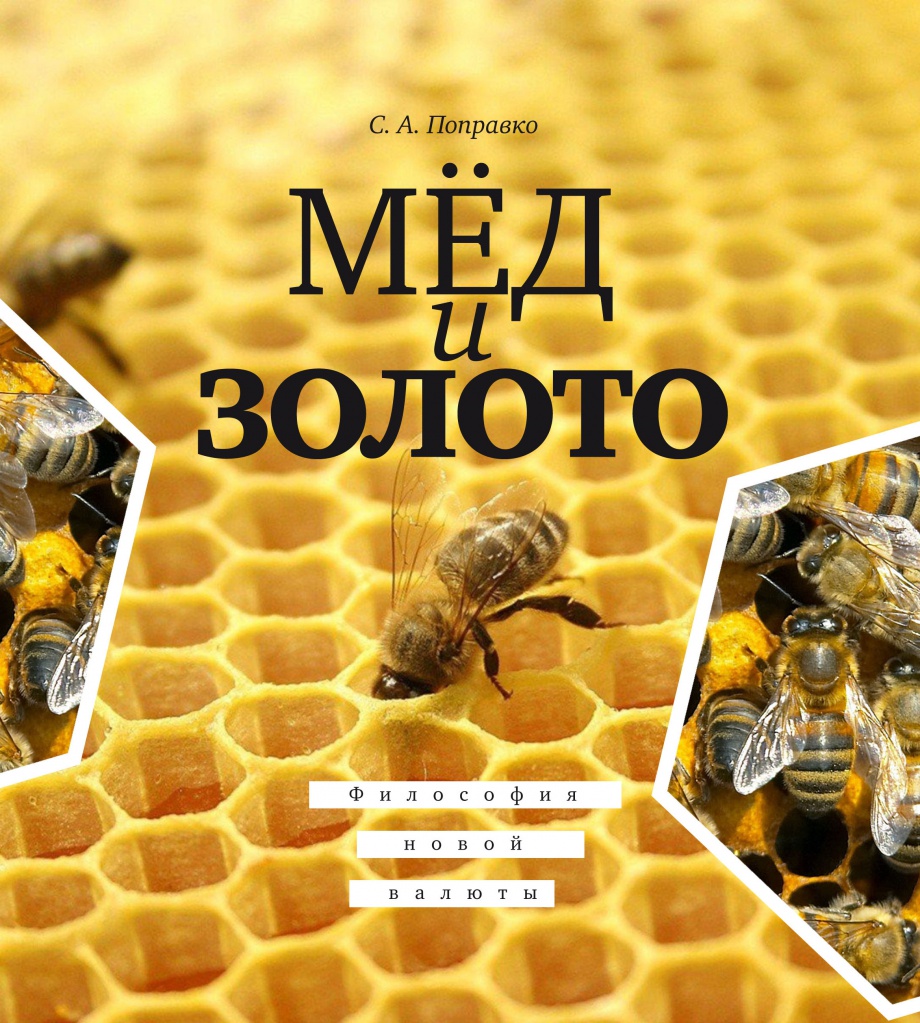 | This book is written by the well-known scientist-chemist S.A.Popravko who was generally recognized in 1960-80th as discoverer and researcher of chemical composition of propolis and its sources. Besides that, nowadays he is the author of the new independent unit of value (patent of Russian Federation № 2121442 dated 20.01.1998). Honey is a symbolic product of Nature. Simultaneously it is an ultimate product of exchange work of bees, their peculiar currency and universal money accepted in any bee communities. It applies not only to these communities but to the world of people as well. Honey along with bee wax was the major currency in trade relations of ancient Russia, and there was no threat of disappearance of its sources. For those people, who began to develop material resources of lithosphere, Nature offered special metal of Earth - gold as the valid money. Their truth is contained in this metal. And it is not less important than the truth of honey, a symbol of life sweetness, though with some bitter tinge of insuperable crises and contradictions. Their creative dialogue - dialogue of honey and gold, bio –and lithosphere, mediated by human intelligence - can help to find those values, which have been lost on turns of scientific and technical progress, and which still are escaping from people. It is that truth that helps to endure bitterness of problems. Truth of new currency. This currency is quite commensurate with those ways, by which Nature and its superior social forms, that have presented to people and our planet bee honey, mentioned in title of this book, follow… |
PREFACE
Beer honey is the highest achievement of Biosphere, of its social or labour forms. It is a sweet kiss of flowers and bees to man, a message, which contains information about possibility of delightful harmony of the world of nature and the world of labour. It is the world, in which man, who is capable to learn, study, acquire knowledge, skills and to work, creating the own environment of life, is invited. Armed with more and more perfect arsenal of scientific and technical progress, he creates his own civilization, which is capable to change and reshape our planet. This "parallel" civilization, created by man, gives him a great deal of things but, alas, it can not give him the main thing: natural forces of life. But it is the force that feeds and support his health and can give longevity provided by genetic base. Bees can offer us unexpected decisions and help. In this book we shall talk not only of honey but of life terms and of … money, to be exact, of gold - their truth. Of money, that nowadays has lost a part of its main functions, as if forgetting its main destination - to maintain civilization of people, to be a true and constant measure of social activities, to not lose its value for many years. Let us look and think together. There are very beautiful and graceful ways of decision and outcome of many problems. Though with some efforts, let us venture to leave circles and spirals of our "parallel" civilization. Having felt ascending force of four-wing angels of fields, we shall deflect for some time from glossy – glam trinkets of materialistic society. It is that moment when prompting message of honey-creating bees … should be heard … | 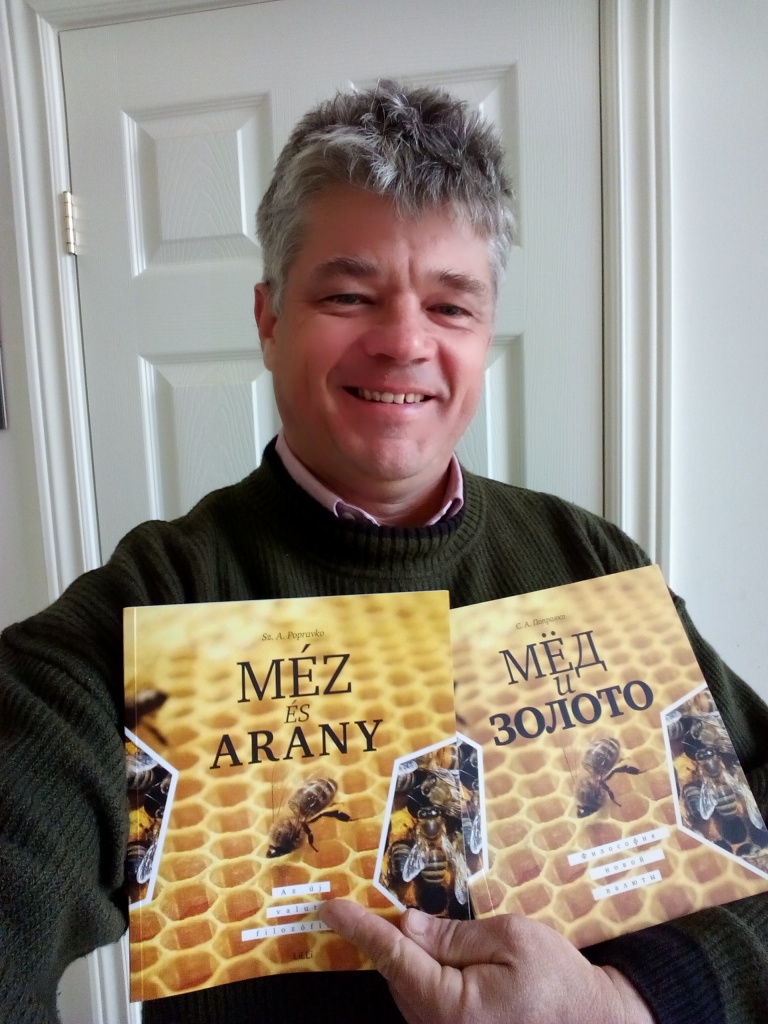 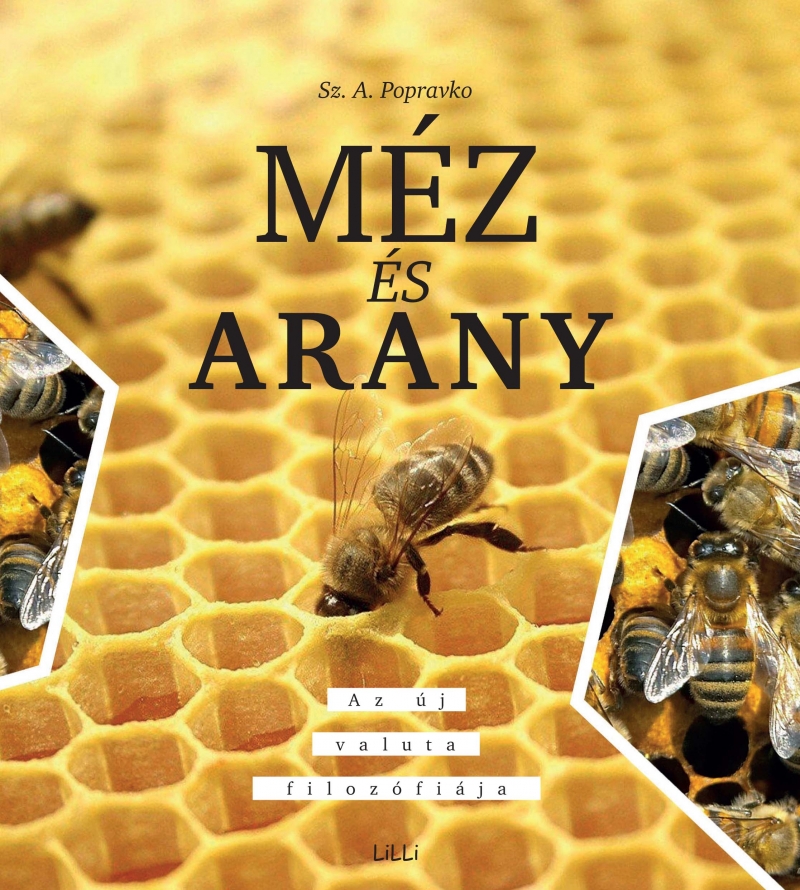 Dr. János Körmendy-Rácz Bee-keeper, Apitherapist, President of the Hungarian Apitherapy Association, Vice president of the Special Committee of Apitherapy of the World Federation of Chinese Medicine Associations, Hungary S.Popravko “Honey and Gold” was translated and published by Li Li Kiado publishing house (Hungary) http://www.lilli.hu/shop/product/15244/mez-es-aranyszamozott-konyvritkasag-elfogyott.html https://erista.hu/mez-es-arany-sza-popravko-7672 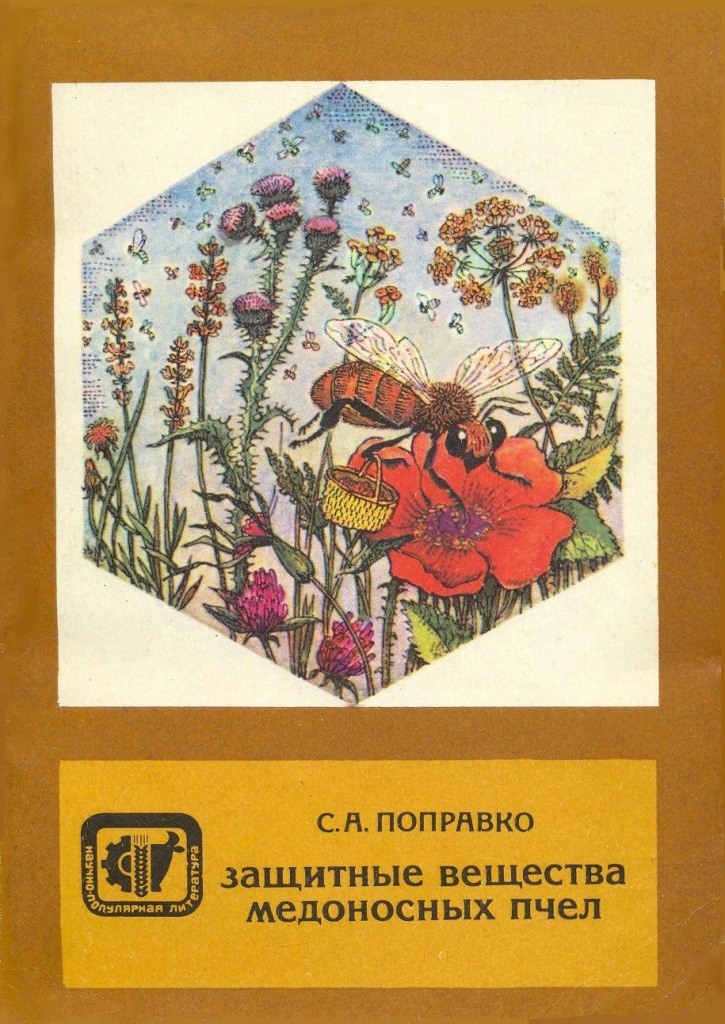 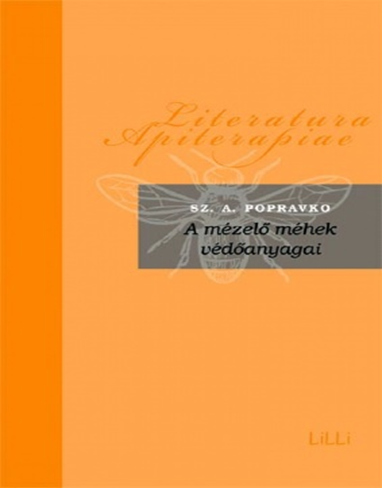 S.Popravko "Protective substanses of honeybees" was translated and published by Li Li Kiado publishing house (Hungary) http://www.lilli.hu/shop/product/15253/popravko:-a-mezelomehek-vedoanyagai.html |
--Sergei Alekseyevich, tell me about your research into propolis. Where and when did you begin and what were the results of it? What did you manage to learn?
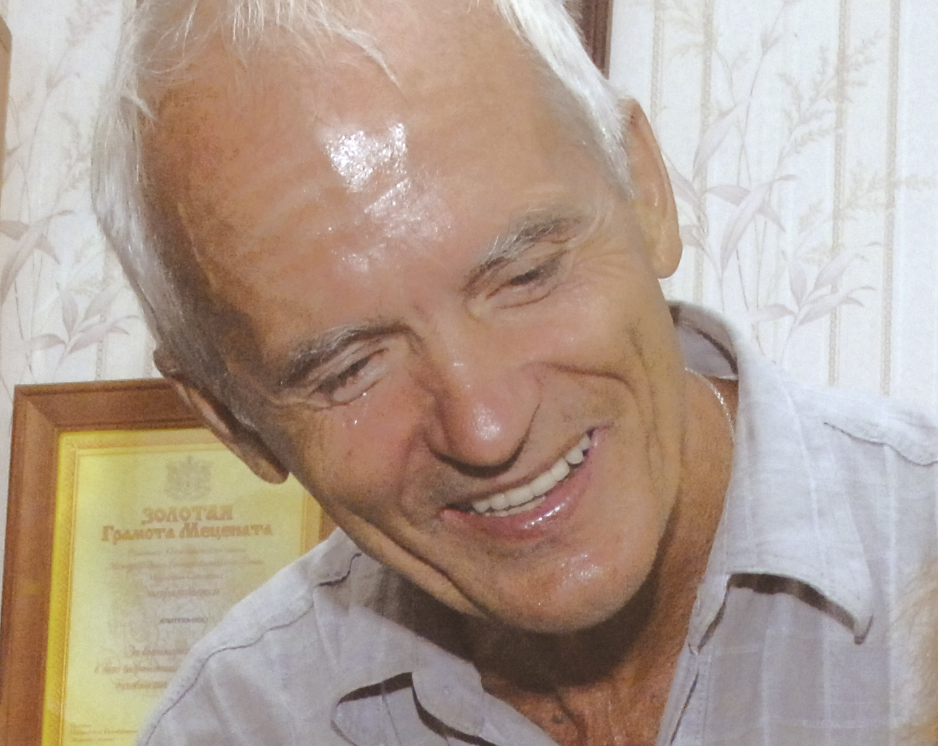 | --It is a long, but interesting and even romantic entertaining story. The book “The Protective Substances of Honeybees, M. Kolos, 1982”, which was published in 1982 by the Kolos Publishing House in Moscow, goes into quite a bit of detail about it. Research into propolis began to be done in the Laboratory of the Chemistry of Antibiotics at the Institute of Chemistry of Natural Compounds of the Academy of Sciences of the USSR. The institute of the “chemistry of living things” was headed then by the vice president of the Academy of Sciences of the USSR, academician M.M. Shemyakin. He oversaw the laboratory of antibiotics and was my scientific supervisor for my Ph.D thesis. It was connected with the synthesis of tetracycline. |
Research into propolis began to be done in the Laboratory of the Chemistry of Antibiotics at the Institute of Chemistry of Natural Compounds of the Academy of Sciences of the USSR. The institute of the “chemistry of living things” was headed then by the vice president of the Academy of Sciences of the USSR, academician M.M. Shemyakin. He oversaw the laboratory of antibiotics and was my scientific supervisor for my Ph.D thesis. It was connected with the synthesis of tetracycline.
It must be said that the institute’s work was a subject of discussion at the Plenums of the Central Committee of the CPSU. It was decided that the institute was to try to find effective means of keeping the population healthy. Both in ordinary and in extreme conditions.
It was an era of great faith in antibiotics—strong and reliable medicine able to quickly help a person. It was also the time of the Cold War, of stiff and uncompromising competition with the West that demanded absolute victory, for it couldn’t have been otherwise for us children of World War II. And it should be noted that our laboratory of antibiotics held a worthy and, at times, leading position in this competition. It was the first, for example, to synthesize tetracycline. In it, ¾ of the ring system of the molecule (BCD) had been part of my Ph.D thesis.
But, as it often happens, problems nevertheless remained in successfully fighting off microbes. When very strong and effective antibiotics were used, the microbes developed a resistance to or adapted to the active substance. It was then that I recalled that there was a system of amazingly reliable and effective protection against microbes in nature. It always demonstrated 100% sterility and practically the complete absence of any microflora.
It was the beehives where nectariferous bees lived. I was very familiar with their atmosphere since childhood. I had love and a passion for bees already as a child and when I was 11 years old I found myself providing honey for my whole family.
As for sterility, the first experiments confirming such a phenomenon were done by an American bacteriologist, White, in 1905. He ran a sterilized platinum stick across different parts of a beehive and then put it in a thermostat with a nutrient medium for microbes. Each time hardly any were found.
The beehive manifested practically a complete absence of any kind of microflora. However the reasons for such sterility were not discovered.
The French scientist Remi Shoven and Piere Lavi contined the research into the substance responsible for the ideal atmosphere of the beehive half a century later, in about 1960-62. They determined the degree of antibiotic activeness of all the substances contained in the beehive—the honey, the comb, the bees’ poison, the bees’ bread, and the bees’ bodies themselves. And they finally learned an amazing fact.
It turned out that the substance responsible for the 100 per cent sterility of the beehive was no other than propolis or bees’ glue. The aromatic resinous dark brown and greenish substance whose chemical nature had remained a secret because of its complex composition.
The French researchers called propolis the “key to the anti-microbe defense of the beehive”. They invited the best chemists at the Institute of Chemistry of Natural Compounds (headed by Mishel Barbye) in France to do further work with them.
The chemists managed to identify the first five compounds in propolis. They were flavonids and two of them--galangin and pinocembrin—have some antibiotic activity. At the same time the German taxonomist Wollenweber identified these very same compounds in the resinous secretions of the buds of the black linden tree (Populus nigra) which grows all over western Europe. And then the corresponding conclusion was made that the resinous secretions of the buds of the linden tree were the source of the western European propolis.
It must be said that all these facts given in the articles of Remi Shoven and Pierre Lavi in 1962 greatly excited me. The chemical nature of the propolis collected by bees in Russia hadn’t been studied yet then. The sources of it in our northern latitudes where the black linden doesn’t grow had not been found out. But mainly this determined the unexpected future success of the results of the search.
In those days it was very hard to get the administrators to be interested in this subject. Antibiotics were being looked for in the metabolites of mushrooms and all scientific hope was connected with the search for an extremely active and each time new compound. Compounds possessing medium activity didn’t evoke any interest, though it was them that could give an invincible, reliable and orderly system of protection against microbes that was much more effective than one strong acting antibiotic to which bacteria would inevitably adapt.
As the results of the determination of the antibiotic activeness would show, the “group” effect in propolis is clearly manifested. It is manifested in the significant jump in the general activeness from the joint action of the medium active compounds. Such an effect turned out to be characteristic of the phenomena of social or aggregate biochemical protection. And it looked like this held the key to the search for a universal way to protect mankind’s population centers from microbes.
After all, bees are a megalopolis in nature.
In short, all that inspired me to do more research…
--So how did it go?
Source No. 1 for the bees of the middle Russian plains—the long and “detective” story of the search for it is described in a book2--turned out to be the aromatic resinous secretion of the buds of the Russian white birch (Betula pubescens). These balsam “tears of the trees”, as the ancient Greeks said about such a phenomenon in nature, could be poetically called “birch tears”. Oozing these tears, our favorite white trunked tree secretly cries in warm and hot times of the year. That was an amazing fact! According to the results of the chromo-mass-spectrometer identification, the main characteristics and composition of the biologically active compounds secreted from the balsamic birch buds totally corresponded to the characteristic core of the compounds identified in the propolis collected from the buds. But that is not all. It turned out that the substances found have long been used by Russians in their bathhouses where they beat each other with a birch switch to keep themselves healthy. If you take a good whiff you will immediately realize that the aroma of the aromatic propolis in the beehive and the smell of the hot steamed birch switch in the bathhouse are one and the same! That is the bees and man independently of each other— millions of years for bees and thousands of years for men—have been using the healing force of “birch tears” to guard and keep their health. Such a double certification by Big Time itself! That was a beautiful and accurate chemical picture confirming the sources of Russian macrobiotics. After all, a bathhouse with a birch switch and the products of a bee family are the attributes of the traditional Russian way of staying healthy. The first publications about the results obtained came out in the journal The Chemistry of Natural Compounds in 1969. All the work done was written up in them. Later, articles about it were published in other scientific journals. They shook the world. Letters rained down on me as well as requests for the article from all over the world. We became famous overnight. | 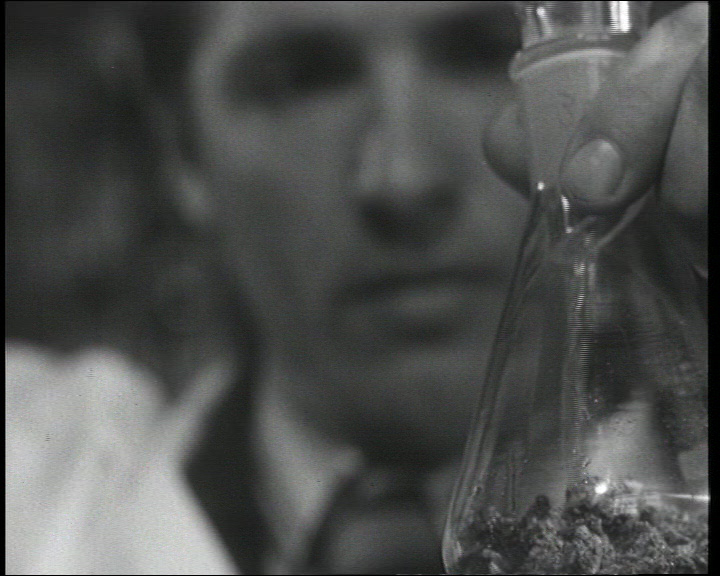 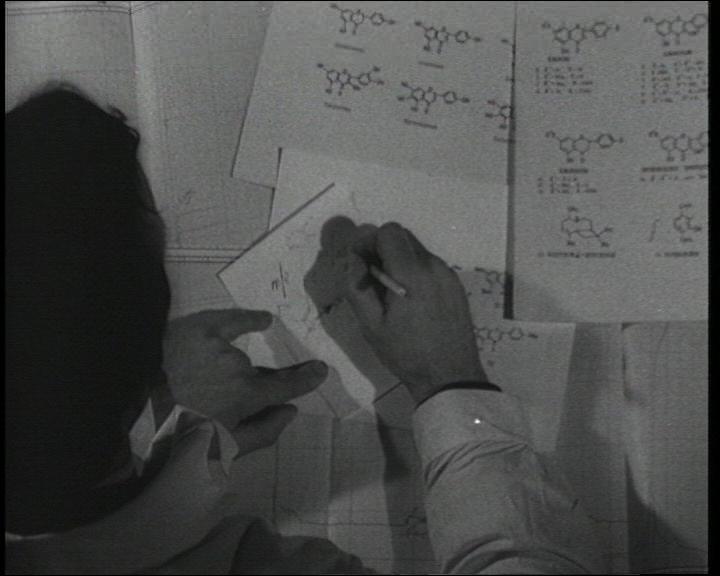 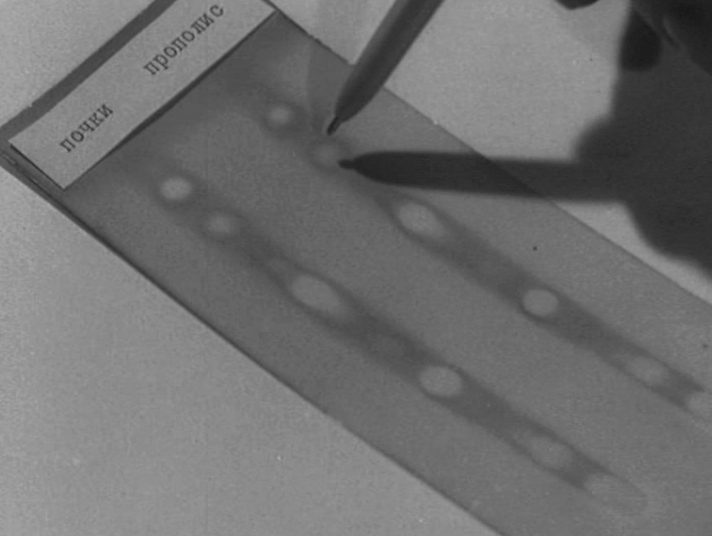  |
|---|
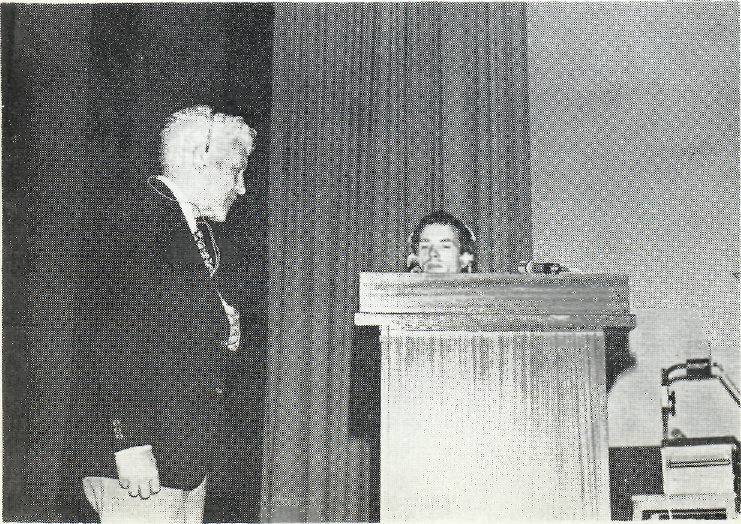 S.Popravko and Remy Chauvin | At the II International Symposium on Apitherapy in the city of Ljubljana (Yugoslavia) in 1978, the chairman, the French entomologist Remy Chauvin, handed me his own gold medal, and his student Philipp Marchalan began studying the Russian language in order to read my works in the original. Philipp wrote 2 big reviews of our research in the journal Apiculture de France. They were titled “Investigation into Propolis”. And the train of western fame stretched to the USSR. Articles began to appear in various journals: What is Propolis in the journal Chemistry and Life, The Secret of Birch Tears and Bee’s Glue in the journal Science and Life in 1975, as well as articles in the newspapers Izvestia and Trud. I spoke on the All-Union radio station. In 1978, a popular science film, The Almost Discovered Secret, was shot. It would be shown in movie theaters just before the feature film. But all this was devoted to the success of exclusively scientific achievements. The road to the practical application of this discovery, to creating a new emulsion capable of giving the blessing of Russian propolis to the body of man and his skin, still lay ahead. And it, of course, was a thorny path. |
--When did the new emulsion come into being?
The emulsion would come into being only 10 years later, at the end of the 80s. And it took about that much time more for it to be adapted to the users and be certified for sale on the market. That period fell on the times of perestroika in our country and its entry into the world economy, so voluntarily or involuntarily it was in competition with the cosmetics of well known Western producers. However, being a true one, it won out.
Western scientists called our Russian propolis the Russian penicillin after its systemic acting, blocking, anti-microbe and antioxidant properties were discovered. After all, the air in a birch woods is not only more life-giving, but also cleaner than in many sterile operation rooms.
Our colleagues at the Institute of Chemical Physics of the Academy of Sciences of the USSR called propolis “an antioxidant bomb” after finding a whole range of substances with high antioxidant activity in it, i.e. the ability to suppress the action of the active radicals of peroxide—threat No. 1 for a person’s health and the reason for early aging of the body and its vessels. After all, the resinous balsam of the “birch tears” is an ideal defense for the tender green skin of the birch buds, reliably protecting them until they begin to unfold into leaves actively responding to the sun.
| The reaction of the West to the discovery of the source of Russian propolis and the prospects that it had was instantaneous and explosive. Perhaps it was due to the fact that France, Bulgaria, Czechoslovakia, Yugoslavia, Poland and other European countries had been oriented on using the products of the beehive in medicine and cosmetics. And more than 60% of all apitherapeutic remedies produced in Europe were based on propolis. The lack of clarity about the chemical composition of propolis meant that it could not be standardized according to concrete compounds nor its types certified and this kept propolis from being widely used in different branches of medicine and cosmetics. The apitherapeutic preparations on sale then were complex multi-component mixtures. It was difficult for them to compete with the official chemical medicines and cosmetics that had exact formulas for the compounds in them and prescribed doses when used. Therefore the contribution that the fundamental science of the country made to the study of the chemistry of propolis is hard to exaggerate. Thanks to this research, propolis got a chemical “passport” and, then could be subdivided into types depending on concrete characteristic compounds in correspondence with the criteria and methods of chemical taxonomy. This was able to be done only after our research.Only then could propolis gain entry into official medicine, cosmetics and other spheres of the production of health products. We created a system of highly sensitive color reactions and effective and quick to do chromatographic methods of testing that made it possible to differentiate and choose the best types of propolis. Then we could give them a strict chemical-taxonomical description, a kind of “biochemical passport” for each type of propolis. These “historical samples”, compounds that we were the first to single out and identify as well as work out the methods of determining them, became the basis for the unification of the methods of certification of propolis in our country and abroad. In our country--for working out the TR(technical requirements) for producing the preparations Propotsium(Tallin) and Proposol (Biisk); abroad--for research into the types of propolis in various countries around the world (Brazil, Canada, the USA, China, Bulgaria, the Czech Republic, etc.) These samples and methods would become part of the basis of the standardization of the products of the companies Sigma and Biomedicals (USA), large world suppliers of standard types of reagents, chemicals and compounds secreted from natural sources. Only then could propolis gain entry into official medicine, cosmetics and other spheres of the production of health products. We created a system of highly sensitive color reactions and effective and quick to do chromatographic methods of testing that made it possible to differentiate and choose the best types of propolis. Then we could give them a strict chemical-taxonomical description, a kind of “biochemical passport” for each type of propolis. These “historical samples”, compounds that we were the first to single out and identify as well as work out the methods of determining them, became the basis for the unification of the methods of certification of propolis in our country and abroad. In our country--for working out the TR(technical requirements) for producing the preparations Propotsium(Tallin) and Proposol (Biisk); abroad--for research into the types of propolis in various countries around the world (Brazil, Canada, the USA, China, Bulgaria, the Czech Republic, etc.) These samples and methods would become part of the basis of the standardization of the products of the companies Sigma and Biomedicals (USA), large world suppliers of standard types of reagents, chemicals and compounds secreted from natural sources. At that time I was invited by the well-known Yugoslav firm Medoks as well as by the pharmaceutical company KRK, to jointly create a preparation based on propolis. For propolis is the moving force of apitherapy. And around 80% of all characteristic compounds of propolis were first identified by my scientific research group here in Russia. It must be said that we had the luck to study the most chemically and biochemically significant type of propolis—northern Russian propolis, or “the Russian penicillin” whose source is “birch tears”. It turned out to also be the least allergenic in comparison, for example to the propolis collected by bees from the buds of the black poplar (Populus niegra) which is widespread in the countries of southern, central and western Europe. It fell to us to study the classical type of propolis that is, certainly, the most effective in its antimicrobial and antioxidant properties. It is not for nothing that it is called the “Russian penicillin” in the West. | 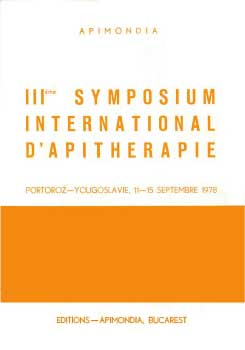 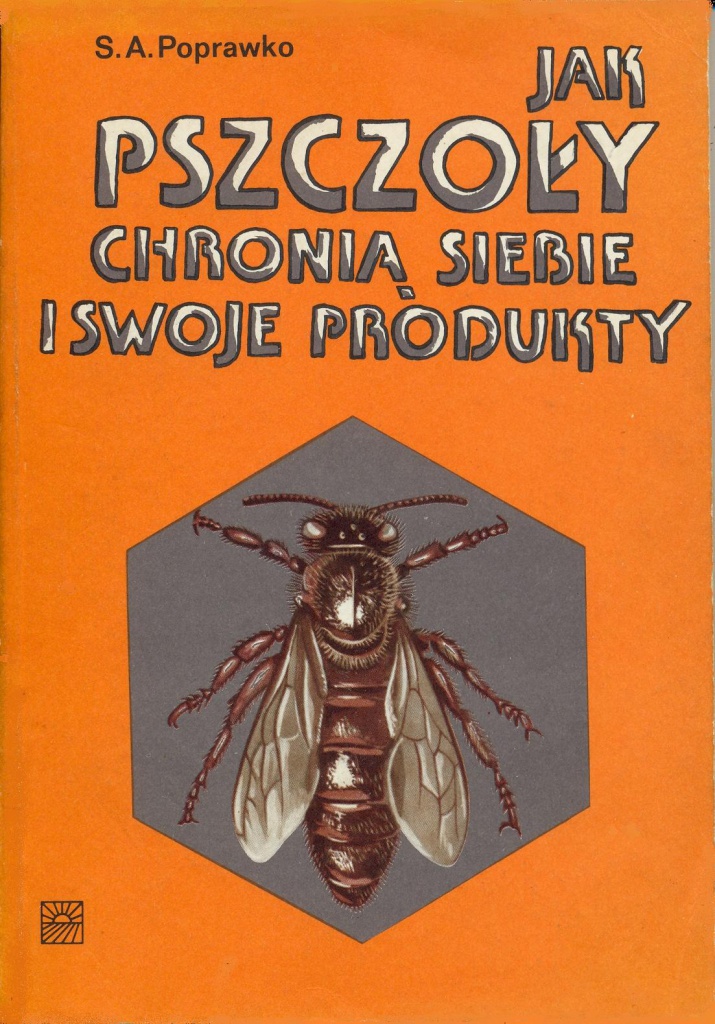  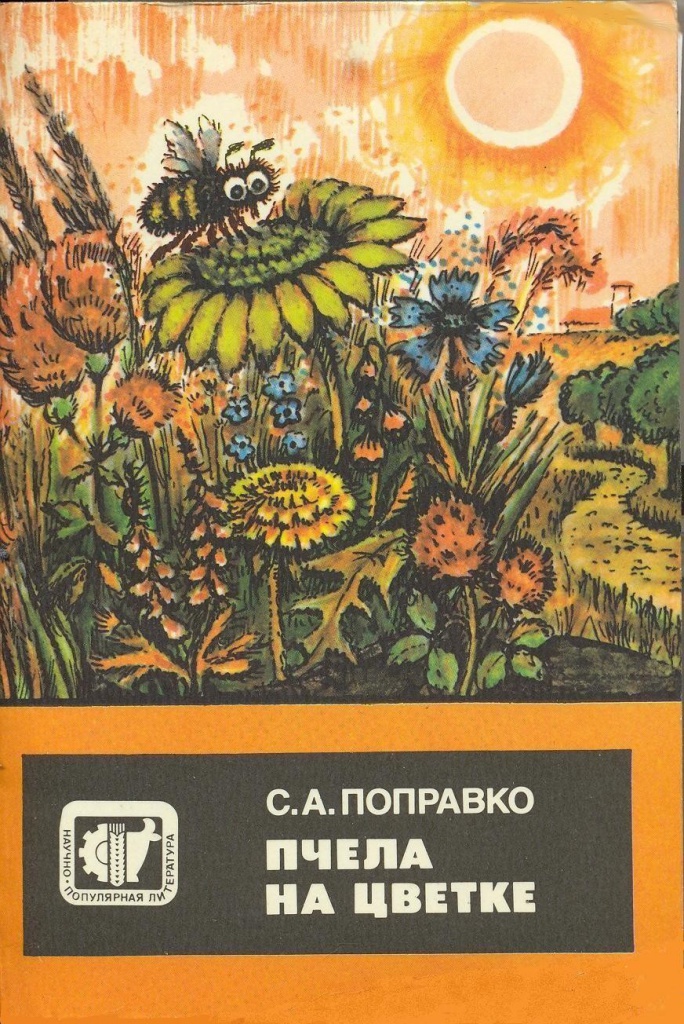 |
--Please tell about the creation of the new emulsion in more detail. How did your cream Morning of the Queen come into being?
We saw from the genealogy of propolis that it is a perfect system of protecting the buds of a tree in most different periods of its life. That protection, first of all, is the protection of the surface of the buds of the tree and of the area around it.
Understanding the role of “the woods tears” and propolis was crucial-- its first purpose was to protect the outer cover of an organism and body. For man the mission of propolis came down to the reliable protection of his skin and the surface tissues of the organism and its vessels.
However, in order to bring this blessing to man, it was necessary to find a way to optimally get the systemic acting substances of propolis to his skin in the most convenient and acceptable to the skin and user form.
So we needed to create a new, non-chemical emulsion ideally compatible with the natural fat cover of the skin of man. An emulsion of a more valuable type for the skin—a “water in oil” or “reverse” emulsion which there is a lack of in cosmetics today. Cosmetics had gotten such emulsions only with the help of artificial ingredients—surface active substances (PAV) which were completely unacceptable to solving the problem. What was needed was an irreproachable ecologically pure emulsion absolutely safe for the body and skin of people.
We conducted hundreds of experiments using traditional approaches to cosmetic chemistry, but that was fruitless. What we needed was a reverse emulsion possessing high transdermal properties, but to get it by non-chemical methods was complicated.
But bees had such substances. Bees feed their larvae a special food—“bees’ jelly” (or mother’s milk) through their thin and tender skin the first 3 days of their life.
So we had to delve into the chemistry of still more complicated molecules, even more complicated than what we had studied in propolis. And then one day fortune smiled on us.
I got an amazing beautiful snow white emulsion better in appearance than all those emulsions which we had gotten earlier using the methods of traditional cosmetic chemistry. This emulsion smelled wonderful, giving off the aroma of learned secrets, of goodwill and of success.
The name of the cream came to us immediately and naturally—Morning of the Queen, symbolizing its new mission for skin.
The “code of the queen” was in this emulsion and it brought with it all the blessings of Russian propolis—“the Russian penicillin”. It had a triple effect—it was an absolutely safe new emulsion that had all the best protective properties of Russian propolis and the regenerative force of “queen jelly”. And all “creams”—in one cream(!)—for our patient and mistreated skin.
Let me explain again that “queen’s jelly” is a special high status food or super emulsion in nature which exists only where there are social living bees. It programs the new skin cells for timeless youth most clearly manifested in the life cycle of bee queens—the egglaying queen bee of the beehive.
| It is “queen’s jelly” that makes it possible for the queen bee not only to live 10 times longer that the common worker bees who eat the usual honey but to also lay thousands of eggs each day whose overall mass will many times exceed her own. This substance is the highest standard of the gerontological blessing of Nature. For man, for example, such a lengthening of his lifespan would mean his living for centuries. But so far such an achievement has been observed only for socially living insects—honey bees. And this is the highest level—the record for social biochemical Nature. And the formula of the cream “Morning of the Queen” turned out to be very successful, reproducible and reliable. The cream has been serving women for almost 20 years now. They love it and will love it, as well as other such creams that solve some or other particular problem of the skin and health of man. In 2008 the cream received a special award—it was entered into the Federal catalog of records of the Russian Federation as “a qualitatively new phenomenon in the world of cosmetics”. --So not only previously unknown laws and knowledge, but the sources of true cosmetics were hidden in beehives. In the word beauty (krasota-in Russian) don’t you hear the combination honey comb (krai sot in Russian)? Naturally the honeycomb of bees is what invites us to turn to this source. Beehives are the peak of biochemical evolution of the biosphere. It is the level to which the highly coordinated and orderly labor taken to amazing perfection over the millions of years that bees have been living on Earth and filling their combs with honey is invited. Look closely, the very appearance of the cubicles and the slabs full of honey reminds one of the sweet pages of the book of Nature inviting us to read them. The treat and reward for curiosity and trying it are immediate! As well as from the flower, which gives its nectar to the bee that has flown up to it. | 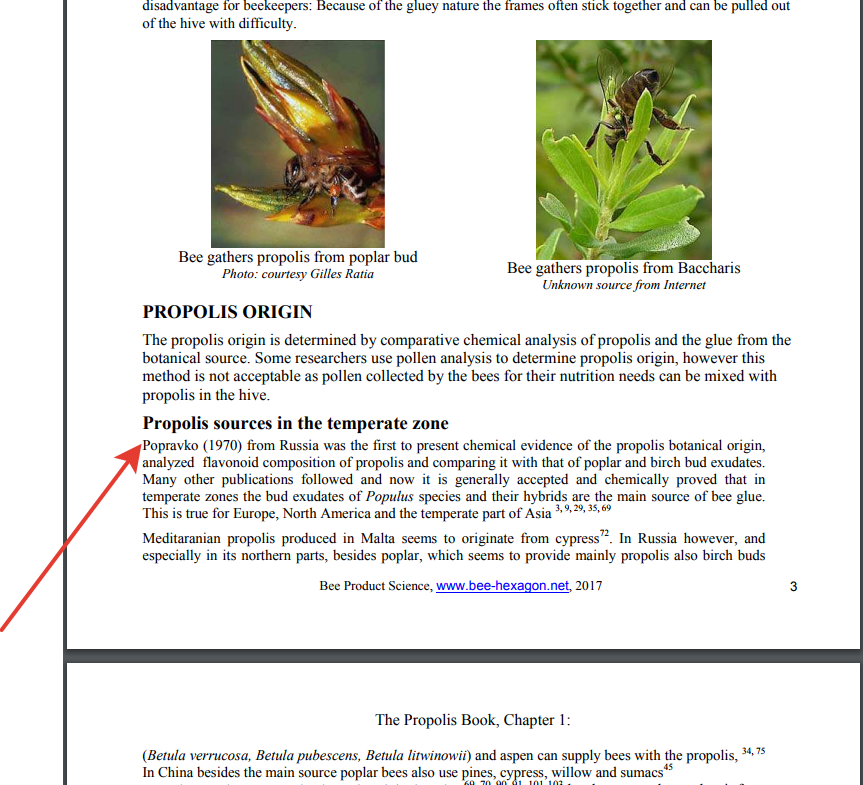 |
Isn’t that Nature prompting us, indicating where we should search for the sources and truths? Wasn’t it in them that the ancient Egyptians found their best recipes: Egypt was the home of priestly cosmetics and “eternal paintings”—encaustics done with hot wax paints. After all, the encaustic works—fayum portraits and Coptic icons--have stood the test of time unlike other methods of applying paint that have been used.
What has been created later is not always better than what was used before.
Bees created a civilization based on the voluntary gift of the flower—nectar. Their best medicine—propolis—an aromatic balsam, was also a gift, but collected from the resinous drops, “tears”, of the buds of a tree.
Bees, like no other species on Earth, have managed to build their house, a beehive, significantly earlier than our human civilization did. In bee families and hives the ideal natural megalopolis has long been organized, and their environment in which they are protected by propolis is ideal.
Bees not only perfectly protected the atmosphere of their home. They have helped and continue to help other species--nectariferous flowers—leave descendents that are more viable and generous in secretion of nectar. The bees were able to create a special high status food for the queen bee: the life-giving nutritious emulsion queen jelly or bee’s milk. No other species inhabiting our biosphere has it.
The perfection of this food is such that the queen bee, as we mentioned earlier, eating only it, is able to lay thousands of bee eggs, those pearl-like bars, in the wax chambers every day.
The bees feed “bee jelly” to their larvae only the first three days of their life and to the queen bee all her life. The larvae, assimilating it through their tender skin, grow very fast and don’t fall ill. The queen bee, eating only the “super food”, gets the ability to live ten times longer than the common bee which usually eats the usual pollen and honey.
So man’s dream of living longer is realized in the world of the bees.
The main substance keeping the secret of longevity of the beehive is propolis. After all, for the millions of years that bees have lived on Earth, it hasn’t let microflora adapt to and latch onto the rich reserves of the hive and bodies of the larvae lying in the wax cradles.
It is here that the sources of true cosmetics were hidden.
And not only cosmetics. The beehive is a treasure chest of natural technologies of survival, longevity and health. But all this is only had by them, the bees, a socially living species.
All this seems fantastic to man today with his level of culture and ideas about what is known. But these are real facts that have been revealed to man and we will have to take them into account, turning our knowledge thirsting gaze fully on them
-- How has the study of propolis effected science?
As for new horizons opening for science as a result of the fundamental chemical analysis of propolis, it is possible to say the following.
The brilliant and in many ways unexpected, in terms of the results, chemistry of proplis gave the keys to comprehending the complicated interspecies relationships in the biosphere. It made it possible to determine its key, that is dominant, species, and to understand the structure of their relations and create a precise methodology of their analysis and search.
Not all can be comprehended through visual observation. Chemistry makes it possible to catch the superfine currents of the governing molecules in interspecies relationships and to find the hidden and not readily accessible keys of knowledge to discover the main thing—the secrets of the highly organized and complicated social biochemistry of Nature.
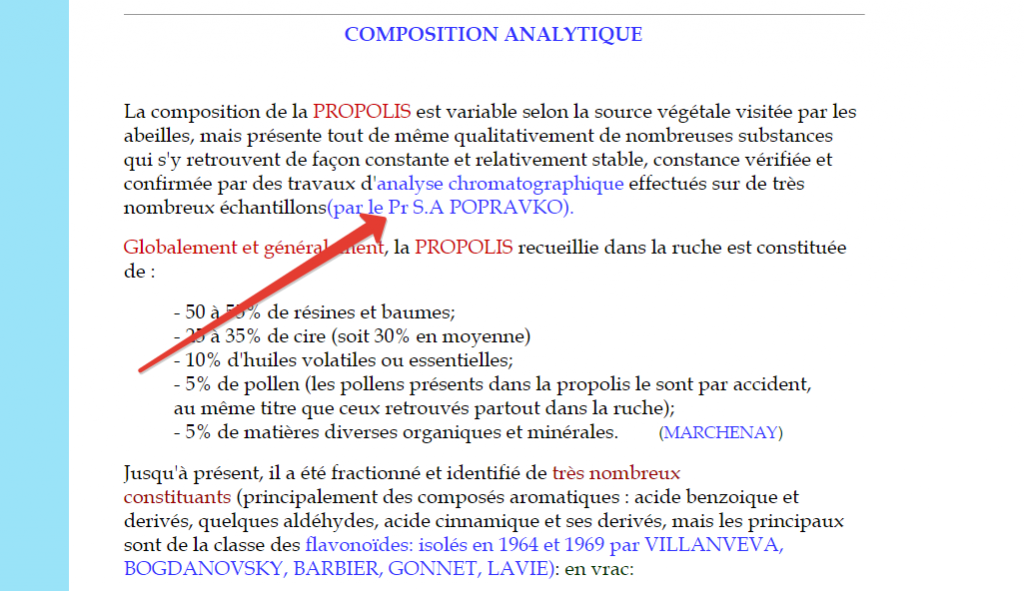 | And later to suddenly and unexpectedly see how the amazing philanthropic forming of our biosphere, the forming of the future life and existence, has been going on for millions of years. Evolution, which is the wise heart of Nature and the universe, forms our biosphere and creates its architecture as an ideal and even too comfortable abode for man, who started down the path of socially organized life much later than the other inhabitants of the Earth. The path, however, has not yet been entirely gone down by man. It is a path full of searching and inevitable going astray and making mistakes. But Nature “believes” in us and this faith is the main thing for man in this life. Don’t we feel its kind, caring and forgiving hand and also its attention? It sometimes sets difficult tasks. But—think—what is stopping us from tackling these tasks, justifying its credit and trust and receiving the highest satisfaction, the satisfaction of our own solutions and victories? In one of my books, A Bee on a Flower, I introduced a new term, White Evolution, a more clear and easy to remember expression for this amazingly deep and wise phenomenon. But it was the bees and the chemical window of propolis discovered by a researcher that helped bring this concept to light. Without doubt, bees are a classical object for ecological thinking, the standard of harmonious relations with Nature and understanding its good heart nurturing man. But we are only at the beginning of this road. |
--What is the main principle of White Evolution and why is it important and necessary to man?
As has already been said in this book, the principles of White Evolution are those already known main engines of change and development—competition and struggle. But competition and development of a special kind: competition in a white way, that is competition in giving more to others rather than taking more oneself.
In other words, the one who can offer its biological community (cenosis) something more, something more important for life that other species can’t offer, wins on the playing field of evolution. This important for life thing is no other than necessary and needed concrete substances, their balanced and timely flow and “delivery”. They can also be regarded as special biochemical services to the community.
Competing to propose them is the essence of the principle.
There are many examples of this and they were given on the pages of the book. But it is propolis, its now known chemical portrait, its origin and the functions of the components of its compounds that is the most vivid confirmation of this phenomenon.
Man, having learned about and accepted the principles of White Evolution and the criteria and parameters of its selection, can look in a different way on the path of his own development. After all, White Evolution affirms not the selfish consumption so widely popularized today. And it is not at all about wearing oneself out in the competition to use the resources belonging to future generations.
White Evolution is just the opposite: it is the laws of the protection and perfection of the environment, the laws of building the infrastructures and improving the quality of existence.
And then, victory awaits those who give more and those who want and strive to give and are successful at it, not those who get more, disrupting the balance of the universe and undermining the roots of their own future.
Thus, through “her majesty chemistry” the bees are bringing this important news to man—the news that only non-antagonistic and mutually supplementary interspecies relations, their joint creative unions, will open the doors to the future. And in that future there will be no threat or anxiety over various possible “ends of the earth”. In that future what today can be called species immortality will finally be achieved.
White Evolution is the attack of the best and the superior, the victory of the active and fruitful. And this is the main thing that man needs to realize now.
If he doesn’t, his consciousness will long be plagued by the gloomy shadows of the various pessimistic and apocalyptic theories causing, as a minimum, depression and a negative mood in society.
--So, in correspondence with this life-affirming principle, what should man do or offer? How should he transform the environment where he lives in order to achieve a qualitatively better state of life in which there won’t be, as you say, any anxiety about the future?
First of all, man should look at the length of his life in a different way. Is it so strictly determined or is it possible that the current average statistical lifespan is much shorter than it could be?
| In other words, man needs to feel the coordinates of Big Time, or the time in which species live, planets come into being and die out, civilizations flourish and become history. These periods or segments of time are called Big Time in the book Honey and Gold in contrast to Short Time or the time of a single person’s life where the immediate goals and tasks keep one from seeing the horizon of the distant future. And as we have already said, man today lives a much shorter life than what primordial nature has allotted him. The book Honey and Gold goes into detail about it. In order to explain and confirm this, the so-called “Law of Krat” was given: the biological dependence of the length of life of mammals, among them man himself, on the length of time to their sexual maturity. It turns out that man lives and acts in only the few decades of life allotted him. But what does he manage to learn in such a comparatively short, and in cosmic dimensions very short, period of time compressed even more because of having to live under the constant pressure of time? Man only manages to reproduce, having given his all in the fight for success and the best place in society. And that short cycle of life reproduction, no mater how fruitful and momentous it was, doesn’t lead to the main thing—the cherished and kingly reward--to an increase in the length of life of not 5-7-10 years, but of 50-70 or more years. Think about it: does man and his earthly community win from such a philosophy—a philosophy locked in the paradigm of a short existence? It is unlikely. But where is the way out then, and is there one at all? Is it possible to change the current situation orienting on other time, other scales, and other horizons where all we have spoken about above is not lost? Let ourselves say “yes”. Because there is a reason to do so. But to say “yes” only on one condition. The condition is that we introduce the necessary changes and corresponding corrections in formula No.1 for our so far not entirely ideal organization of life—in the formula for our money. For it is there, in the formula for money, that the problem of problems lies. It lies in the sphere of a free market economy where, as you know, the old saying attributed to Americans has long been repeated: If you are so smart, show me your money. But if this money isn’t entirely right in its nature, then how can one show it? Alas, in life today we don’t yet see its incorrectness, we see only the mistakes—the consequences of this incorrectness. Among them all sorts of crises at the heart of which lie the stolen or lost “krats” of our lives, our priceless main treasure. The imperfect money is the main reason for the distortions and crises. Its imperfect nature is leading society into a dead end. First of all we need to change the idea of money, having learned its laws. And the bees will help us in this. | 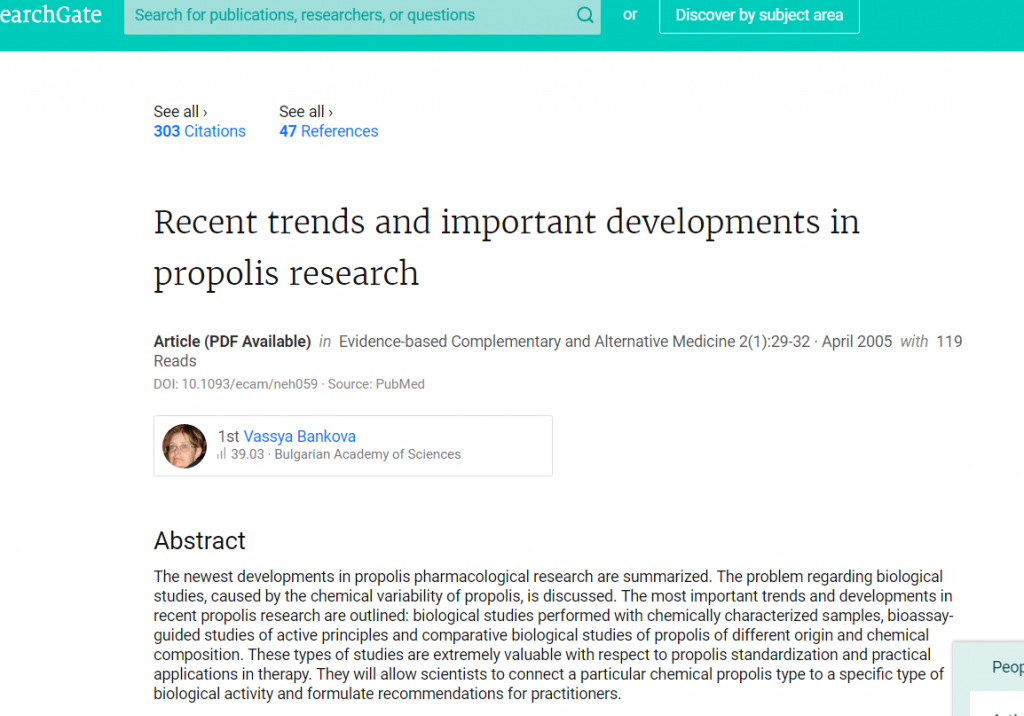 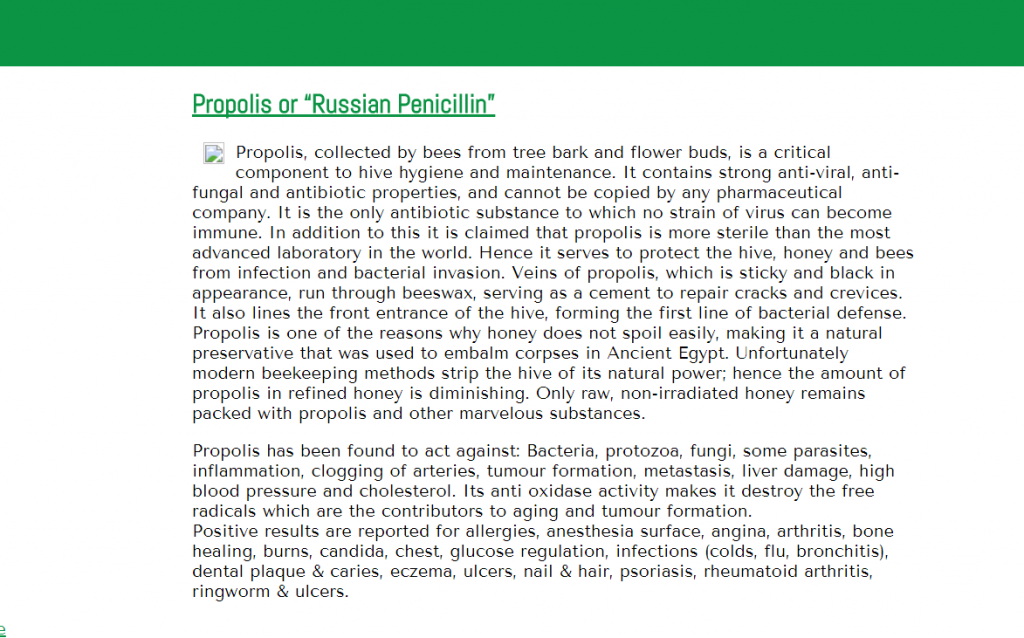 |
--Money and bees, it might seem that they have nothing in common... How did you establish that connection?
The bees world is one of ideal relations in the sphere of special social forms of nature. They, the bees, make a product renowned on Earth—product No. 1—their honey. Bee honey can be preserved for years and decades and serves not only as food.
Honey is not just a “food”, it is a kind of treasure, a high energy source with no time limit on its preservation, thus protecting its value and worth. So it can be used at any time, like money long kept in a sock, as a currency needed by all. It is the highest and final value of the beehive. That makes bee honey analogous to reliable natural money, analogous to currencies ideally good for use also by other species.
Actually, man has long used honey as currency. Honey was widely acknowledged as a means of exchange, a measure of value by our ancestors. It played the role of “liquid gold” and was accepted without any “customs inspection” or calculation of the difference in rates in any communities connected with beekeeping.
Honey was the most important currency goods in the trade ties of ancient Russia which was rich in bees and honey. That went for bees wax too. And in those distant times there was not any threat of their disappearance or of exhausting their sources.
But the civilization created by man needed not only a constant exchange of goods and services, it also needed a true standard for their measurement.
In nature, the analog to such a standard, as we show here, is bee honey. For man, once he learned to extract metals from under the ground, gold became the standard of measurement of value and has been such for centuries now.
The beautiful yellow metal is rarely encountered and therefore especially valuable. It is number 79 in the Periodic Table of D.I. Mendeleyev or the geochemical register of elements of the Earth.
The free exchange of goods and services is a market and money is the intermediary of exchange operations. It, money, makes it possible to acquire and buy all that is offered, and all that is created by talent, labor and the skill of man. It is here that the path of development of our civilization lies—through a market and exchange. It allows man to filter out the best and organize people for joint coordinated work, using their social energies to create something.
The united labor of people makes it possible for man to use what is good in the lithosphere, its resources and metals. Joint labor makes it possible to extract gold, a special element of the periodic table, from the Earth. The geochemical evolution of gold was completed long before there were flowers and bees on Earth. And man, who thinks about everything, only came after them.
| Having mastered the forces of fire and having got the substances in the lithosphere at his disposal, man secured for himself a monopoly on the right to use them. Thus he got not only dominion over the planet, but became responsible for his actions. Gold became the regulator of this dominion, both inside human society and outside it, in relations with nature and its resources. Gold became money which people could always rely on. But later, imperceptibly to themselves, they left its primal truth and submerged into the world of the shadows of gold--the world of ephemeral paper money that dissolved in the flow of time. They continued to do so and eventually there was a world financial crisis, for they had forgotten about gold, its truth, its hierarchical role. They had forgotten about the significance of real substances, those substances necessary for regulating our social and coordinated joint activity—social labor. They forgot about the truth of real substances while using substitutes for them—banknotes. So now they are going through bankruptcies, overestimating their capacities and demonstrating full inability to back their own claims. So now, people--society and governments--will have to restore what has been lost: to return the heart, core and its quintessence to money, to go back to the true standard of money—gold. And only then all the circulating secondary (paper) money can again acquire its purchasing power and significance. And the poor, the rich and the state and the world community, have all now found themselves in the trap of ephemeral secondary money, phantom money, money of the second and third level that is in essence money of Short Time. They are in the trap of money that is unstable--its value changes all the time. It is an unpredictable and unsteady currency with which it is impossible to establish values and in which it is impossible to keep one’s capital for a long time. It is impossible to calculate the profitability of long term and much promising projects in it. | 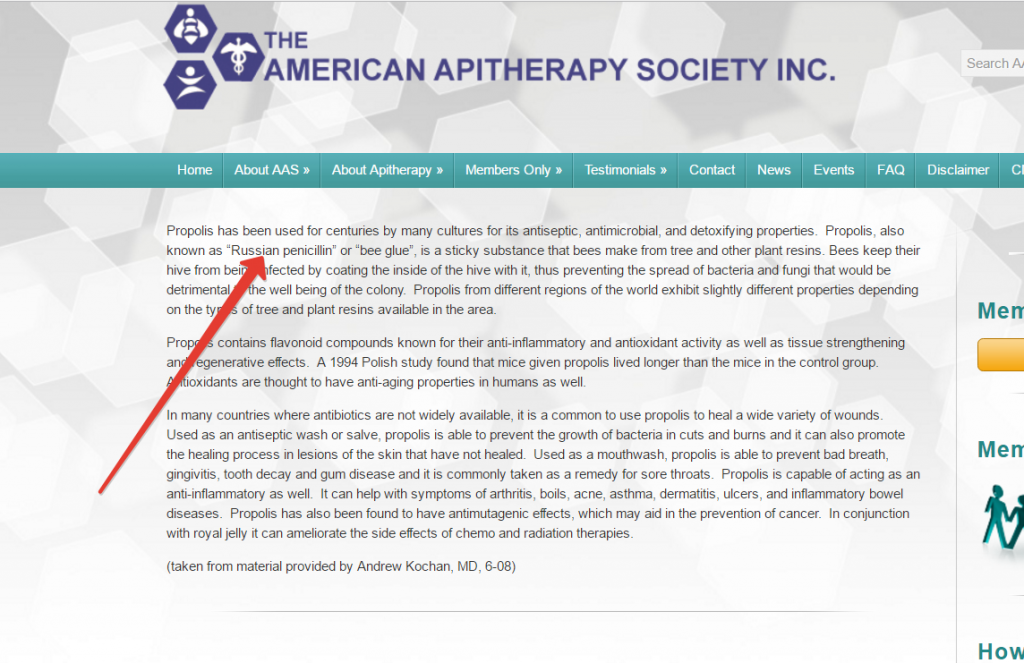 |
Our current capital has begun to devaluate, it is losing its value before our very eyes. That’s why this book has been written: it is about money that is perfected and true, money that is real and possible. Only it can help capital be reborn in order to reliably preserve itself in another form.
All forces and strata of society need money based on gold, on a firm not shaky fluctuating basis. Without such money, capital and its ideology won’t last.
---But mankind, to the contrary, has been striving to get away from the gold standard for many years.
First of all, it should be said that real or true money is gold and only gold. All financial institutes around the world say that. Unfortunately, when gold was taken out of circulation after the American depression in the 1930s, it hurt the economy and the fate of mankind.
Since that time people have simply forgotten about the true designation of that metal. Their hands no longer touch gold money, and now they no longer recall that at one time it was otherwise, that gold was and remains the only universal equivalent, universal gauge of the value of currencies and of any value at all.
It is an objective law, the law of the geochemical register of elements on Earth and there is no changing it. Gold is now sold at exchanges like any non-ferrous or precious metal for some or other currency, determining the value of its troy ounce (31.1 gram). They sell it calculating the size of the deal in those paper and unstable monetary units.
It turns out that the true value of the “king” of money, of gold itself, is determined by “king’s tailors”, who call themselves the king’s deputies. They sew paper clothes with unstable information about monetary forces honestly accumulated by government and private human labor. By labor so disadvantageously exchanged for these easily printed, like mail box adds, monetary tokens with different figures on them and much promising state stamps and signatures.
| An ounce of noble gold has never figured as a means of legitimate monetary circulation anywhere. Soon after abolishing the gold standard in the 70s, people gradually began to forget not only about respect for the mission of the “king”, but also about the concept of “savings” that prevailed in society earlier. At present they already live by the philosophy “buy, buy, buy” or the philosophy of “live today” dictated by the conditional or short living money. Even real estate, a key segment of the market that personifies a reliable investment in the eyes and minds of many, already shows that it doesn’t justify itself in this role. That is why a new unit of value based on gold has been created. It will help return what has been lost with the abolishment of the gold standard. There has to be a new token, but in another form convenient for free circulation and not too rigid for the monetary system as a whole. An ounce of noble gold has never figured as a means of legitimate monetary circulation anywhere. Soon after abolishing the gold standard in the 70s, people gradually began to forget not only about respect for the mission of the “king”, but also about the concept of “savings” that prevailed in society earlier. At present they already live by the philosophy “buy, buy, buy” or the philosophy of “live today” dictated by the conditional or short living money. Even real estate, a key segment of the market that personifies a reliable investment in the eyes and minds of many, already shows that it doesn’t justify itself in this role. That is why a new unit of value based on gold has been created. It will help return what has been lost with the abolishment of the gold standard. There has to be a new token, but in another form convenient for free circulation and not too rigid for the monetary system as a whole. The new unit can and must restore the long living money in the financial sphere. You have already read a detailed description of it in this book. It is a matter of putting 1 gram of chemically pure gold on a paper bill and the consequent parallel inclusion of the new gold unit into circulation without indicating a nominal value in other currencies on it. You can also read about this in more detail in the materials of the corresponding, long registered patents in Russia. The new gold unit has been created to finally overcome the disadvantages of current money circulation filled with inflationary paper bearers. The bees have a valuable currency substance—honey. For people such a substance is gold—a kind of honey having the goal of exchange and true evaluation of human labor not subordinate to any tests of time. | 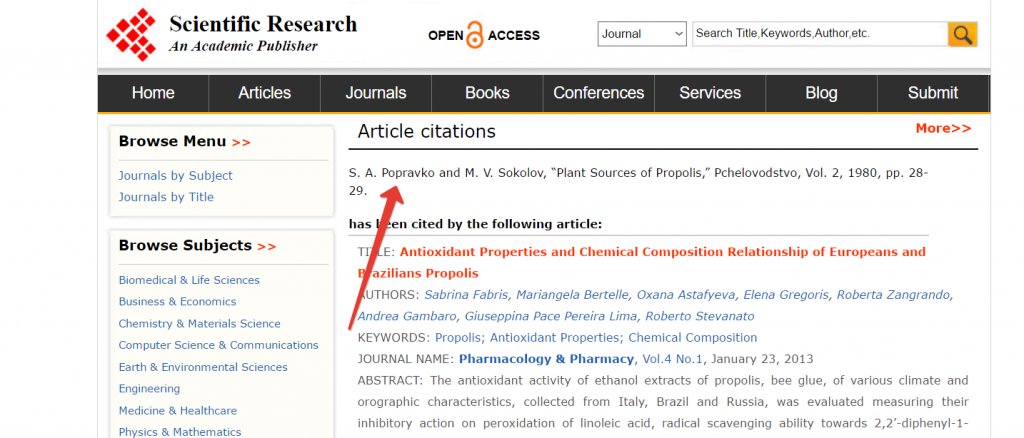 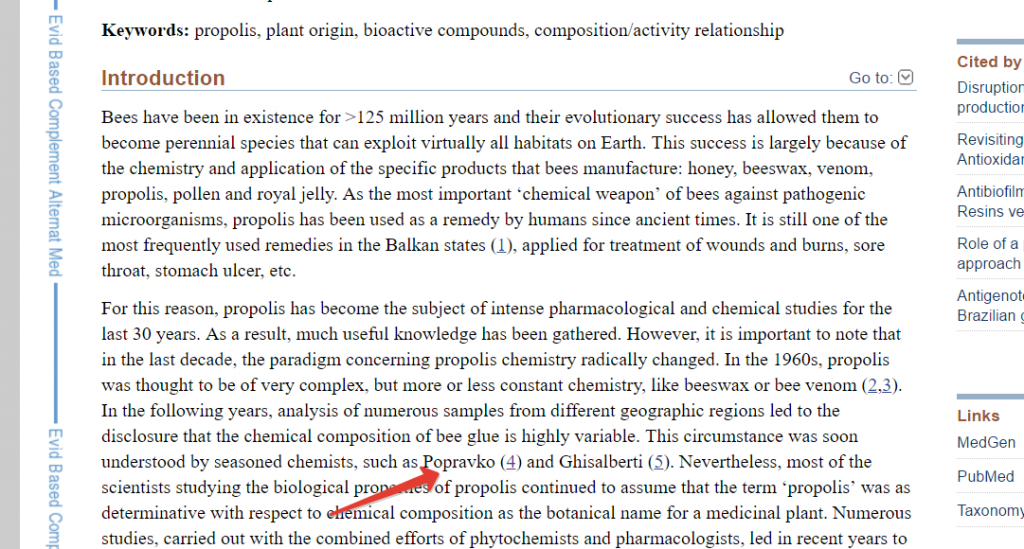 |
The new unit of value is a single universal measure of the value of any currency in the world. Without such an index, all other values are unstable and indeterminate.
But not only this.
Gold is an intermediary substance in the relations of people with natural resources. After all, gold is an important element of the earth’s core, its geochemical register. It does not rust, it is stable and can keep its value independent of the will of states and their leaders for an unlimited length of time.
What else better than gold can serve as such a gauge, preserving the power of any government and the value of any capital?
And what other than gold can serve as the basis for creating an unified measurement system for evaluating and calculating economic indices of long term projects that will take more than one generation to implement.
| Recall that we spoke about the lifespan of humans. What kind of gauge could you use to evaluate the fruits of your labor after many long years? Look closely and you will see that no projects to be completed over 50, 70, 100 or more years are being implemented even in our most advanced world economy at present. Why? Because it is not possible to make up a financial plan and, the more so, to calculate the profit. The new gold-containing independent unit has been created so this can be done. Because there is nothing other than it in which we can do it. It must be said that this new unit of value in no way lessens or does away with the current system of money circulation. Its mission is to enter into circulation parallel to the already circulating currencies, not at all keeping them from continuing to fulfill their functions. The dollar, ruble and euro as well as other national currencies remain and will remain, and all the basic payments will, like before, still be done with them. Unlike gold, paper currencies are credit (or “soft”) money. They are called on to develop an economy, build its infrastructure, and serve as a convenient and customary means of making payment. They are also necessary, this “soft” money, just as gold, now in the new token, is. But the new gold is a universal and absolutely precise tangible gauge of their true value. However, you have already read about this in quite a bit of detail in this book. Besides, this subject is so vast and touches on so many aspects of the complicated and dramatic life of people, including the political sphere, that in discussing it we would need to write more than just one book… | 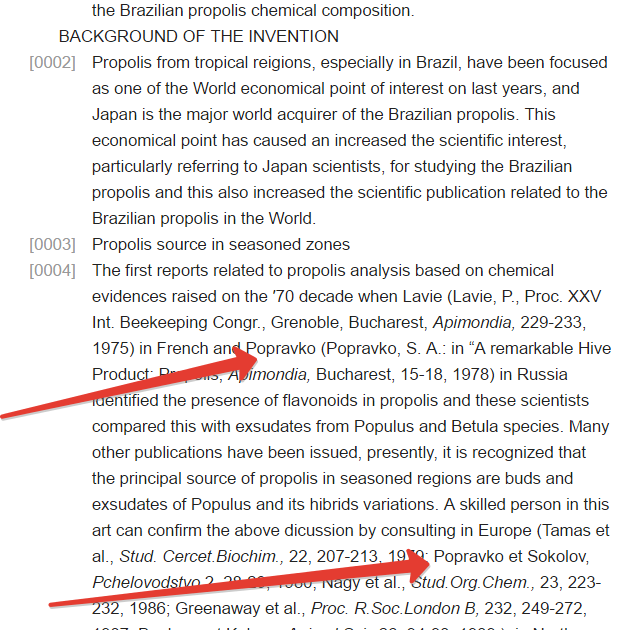 |
---It turns out that money from the bees or “white” money, to use your words, is first of all gold and only gold. For it is gold that is the start and end point, the alpha and omega, of all currently existing and circulating currencies in the world. And we need it now in a new form in order to get out of the crisis. And man needs to realize this. So what lies ahead for our financial system?
That’s not quite right, though it is in essence.
You see, at this stage the monetary system is still far from perfect. It will undergo a total overhaul in order to become optimal. Gold will be in some other form than coins. And then the monetary system will get on its feet, making up for lost time.
We will see gold as a new desired product of the money market, as a means of the reliable valuation of and accumulation of capital, its saving and keeping, and not only of the growth that is now hypertrophied and leading nowhere at times.
But that is all still ahead.
Mankind has always striven for perfection and the bees give us examples of it. The irreproachably exact language of their megalopolis was studied by the great physicist Johannes Kepler. He wrote about it in his 6 volume The Harmony of the World.
Why doesn’t man heed this knowledge?
After all, bees are a species millions of years older than man. They preserve their world created on flowers and perceived by us as an oasis or an island that is a true paradise of life. They reproduce and keep its standards and examples of the very highest value.
Progress doesn’t tempt bees. It has already been made in the million years of their evolution. So they may look archaic and conservative to us, but don’t forget that their archaicness and conservativeness is of the very highest standard.
Their world beckons man, showing him the way to perfection and therefore the eternal. The bees build their honeycombs according to their blueprints and templates, while White Evolution—the creative spirit of Nature, having peeked for the first time into our consciousness, invites us into the future down that road.
The bees are a special “top”, the height of natural and at the same time socially organized life. Their world is like a religion which, by the way, all of them always pay attention to.
Progress in the world where we live is attractive to man because of its conveniences and comforts. All man’s energy and creativity is directed into this sphere. But that progress is a very harmful and unsettling phase in the development of society. Progress doesn’t give satisfaction—the feeling of achievement and the fine. Progress remains eternal stress, biting into the best unlived “krats” of life.
For what looks like the latest peak of perfection today, will already seem ordinary in 2-3 years, and sometimes as a completely obsolete phenomenon. That means that we are living in an imperfect and changing world, in imperfect buildings and cities with imperfect transportation and communications, imperfect health care and medicines and in tangled relations with Nature and its resources.
We also continue to live in a society where there is a lot of friction in human relations, which itself is a violation of the laws of correct social conduct and joint construction.
| And you yourself know that imperfection is fertile soil for any religion. For all live in an erring or “sinful” world. But our civilization, which possesses the resource of self development, is striving for perfection. It is striving for freedom, unfettering the creative energy of man for economic activity. It is striving for the market, and the market, in its turn—for money, for the best money, for their most concentrated and convenient form of exchange, saving and preservation. Gold is the essence of money, its substance. It is a metal representative, a metal symbol of one Sun for all, the material core of all the different currently existing forms of money. And it, gold, is the goal of all market activity, of all the possibilities of legal and illegal exchange. All the forces of the market are centered on that metal. And it, gold, acquiring different forms, is creating savings and capital. True money makes freedom of choice and freedom of acquisitions possible. That is its great blessing. Through it, money, lies the path to the social flourishing of an individual, the realization and recognition of his real significance, his being in demand by other people and society. And if gold is put in money and it will no longer be deceptive, what else could we wish for? | 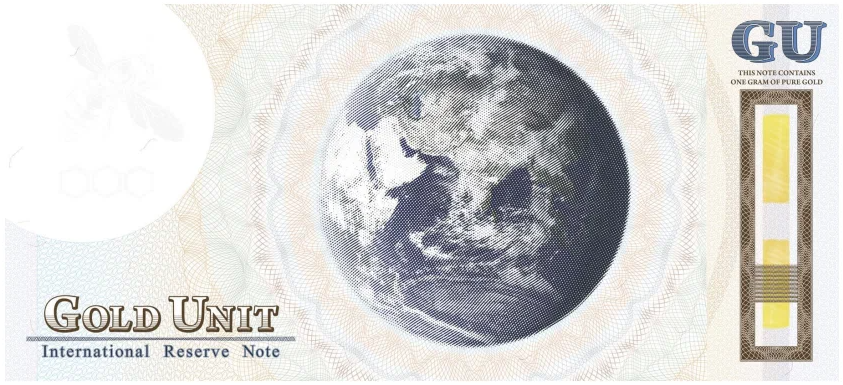 |
---Delving into the chemistry of propolis and the related spheres of natural science helped you see and understand much. First of all to see Nature itself in an optimistic way. All that looks very life affirming, but that doesn’t correspond to the current mood of society which has found itself in a large scale crisis. What can you say in conclusion?
-- Bees bear wat could be called “evolutionary optimism”. They give us a different view of problems and at times an unexpected solution to them, even for those already known money problems of ours.
Therefore, in conclusion I would like to say only what once and for all refutes all the foretold and predicted “ends of the world”.
The bees are an indisputable argument for eternal and highly organized Nature. They have lived on our planet for millions of years. The bees inhabit the Earth not just for the sake of their own life, survival and adaptation.
White Evolution has allotted them another more subtle and crowning role.
Bees are destined to serve the holiday of life on Earth, its continuation, and in the most exquisite and refined forms. Bees collect and store its main treasure—the substances of a flower that has just opened itself to love and happiness. It, filled with aroma, is awaiting an invitation to a new life—it is for that reason that drops of the sweetest drink on earth, nectar, appear on its receptacle.
Nectar was called the “food of the Gods” in the poetic ancient Hellas. Its drops are a kind of accounting of the flowering plants to the Creator himself for their happy and successful path in nature, for their holiday and success—blossoming and the long awaited rendezvous with its angel, a gauzy-winged guest, the nectariferous bee.
It, the bee, descending on the flower from the sky, will fulfill its main and solemn task—to taste the nectar and, having collected it, take the precious load to its honeycomb home, a beehive. It will have to carry the pollen, the weightless balls of pollen where the seeds of genes are packed and hidden. To take them from one flower to another in order to carry out their rendezvous and to germinate and live on. And by doing so continue the great renewal of life so that its current doesn’t fall off or end.
There are other social insects on our Earth—ants and termites, inhabitants of the underground. They continuously and tirelessly work recycling trees that have lived out their lives and maintaining the balance of life in nature. But only bees, who appeared on Earth later than termites and ants, have been given the role of devoting themselves to the most solemn and great restoration of life, its flourishing and holiday of blossoming. And they receive a worthy and corresponding reward—to drink the warm nectar of blossoming plants.
Only bees have been given this mission.
And so Earth won’t be a happy place if the bees leave it, if it is deprived of its treasure—honey, which reminds us of the holiday and summer in other cold times of the year when there is other weather and an other sun.
The appearance of a flower, the nectar and then bees’ honey is stunning and healing for us. Flowers, honey and bees are Eden on Earth. And it continues to flash its abundance. To this day it is preserved in our beehives where life seethes around honey, where people work and their eyes shine with happiness—the eyes of people who have come to love bees and connected their lives with them, having bitten into this sweet “piece of paradise” on our restless Earth.
It is not a fool’s happiness, not the kind promised by an advertisement. It is for real. You can see such people. Their health and psyche are better and they are more attractive in appearance. They stand out because they are more grateful for life. They are careful to preserve its fine connecting threads, the threads of Nature itself. They carefully preserve its directions, behests and compass given, together with a free will, to man by the highest creative force of the universe.
And so there can be no deceit. There is nothing in this world sweeter than nectar, honey and love in the heart. There is nothing higher than the happiness of creation. There is nothing higher than a honey summer when flowers cover the earth, inviting the bees to come for the nectar and when honey drips and people drink mead, when weddings are held and friends get together.
And then the cosmos itself comes to the Earth. It comes where the flowers full of nectar are blazing, where the bees are hovering and people, sharing their happiness, invite the Almighty to take part in their holiday. And those in love, who are living outside time in the excess of their emotions—the nectar of one’s heart, give each other flowers.
The land of the honeycomb is one of eternal beauty capable of preserving this holiday so that our Earth remains the happiest planet of all those known to us in the universe. We won’t further tickle our memory and our imagination with pictures and associations connected with the long time gift of bees—their honey. With its sweetness, with the happiness and honeymoon of newlyweds dreaming of keeping the protective power and message of the life affirming bee-flower kiss all their life. The kiss of selection, success and happiness that fills the meeting with the aroma of the flower full of sweet nectar and the bee that has flown to it. And the creative spirit, the spirit of Nature that we dare call White Evolution, which triumphed at their meeting.
In conclusion, let me add the following.
We tried to combine the themes of bee honey and money on the pages of this short book. For they are not that far from each other in their social essence.
The life of bees and where they live—hives--is surrounded with aroma and harmony. It is an oasis or island of paradise—a paradise on Earth. But it is cellular and so far doesn’t hurry to spread to the life of man. Paradise modestly resides on the flanks of our life, away from our smoky cities and megalopolises.
And not all people on earth and countries had the luck to have bees in the beginning.
Whole continents such as America—both North and South, Australia and New Zeland didn’t have bees—the best guides of White Evolution. The industrious and classical honey bees1 that collect much honey and propolis are capable of overcoming winters and the hardships of any cold climate.
But man and the population of those countries, having recognized the blessing of bees and their products, helped correct the situation. They facilitated the resettling of bees and islands of their Paradise to other countries.
And therefore our life affirming flower-honey White Evolution has no thought of retreating before the future to please the gloomy apocalyptic theories.
Having made its mark in the consciousness of man, it is more and more insistently inviting him to be its creative ally. It is suggesting that he unravel the mysteries of life. It has invited science, that new force which helps see the invisible, hear the inaudible and read the still unread, to be his helper and translator.
And so the “green light” again shines for those discoveries made in the secret quiet of laboratories far from the bustle and monetary anxieties of the world. There where engrossed people make magic, worshipping knowledge and discovering it, reading molecular codes of news coming from the depths of one of the most generous treasures of the world—a beehive.
Through the beehive Nature has woven such a wonderful “honey wreath” for the world—for all the nectariferous flora, for the whole biosphere and the people who have settled it!
Will there be any reasons for anxiety if we read its guiding lines in time? Among them the lines about the best money for our depressed and troubled world.
The world over which its fine face has bent with such attention and desire to help, not letting earthly hope die out.
Will the flowers that you give to your beloved and bees’ honey not tell you about this?
The author of this book was interviewed by Nadezhda Chistyakova


